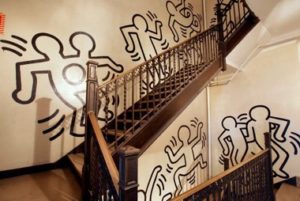[Originally published Nov. 8, 2019; Edited Nov. 14, 2019]
This past October articles appeared in a number of newspapers about the removal of a Keith Haring mural from a stairwell at Grace House, a building owned by Ascension Church and leased for use as a Catholic youth center on the upper west side of Manhattan.[1] Befriended by members of Grace House at a dance hall nearby in the early 1980s, Haring agreed to show up one night at the youth center and paint some of his well-known childish figures in a three story stairwell at the center. He ended up bringing a brush and a can of paint to create “freehand” more than a dozen of his typical childish characters dancing their way up to the top floor. Grace House later closed. The church eventually decided to sell the building. Recognizing the potential value of Haring’s work, they arranged to have the figures cut out of the stairwell walls, preserved, and taken to Bonhams, an aunction house in New York City. They are scheduled to be sold in November.
Haring died in 1990. Since moral rights in the United States is limited to the life of the artist (an unusually brief time given rules around the world), neither he nor his successors had any control over what happened to the mural. If he were alive, however, he surely could have intervened to ask that they be left in place. Section 106A(a)(3)A) of the Copyright Act allows creators of a work of visual art “to prevent any intentional distortion, mutilation, or other modification of that work which would be prejudicial to his or her honor or reputation.” In addition, creators of such works that are incorporated into a building retain moral rights control when the work is installed with the permission of the building owner and a waiver allowing its mutilation or destruction is not signed by the artist and the building owner. Section 113(d)(1)(B). No waiver was obtained here. It is hard to seriously contend that removal of the Haring figures from the stairwell did not mutilate the work and make a mockery of Haring’s reputation. As the picture below[2] dramatically shows, the drawings literally dance up the stairs. That dance is now gone forever.

But in addition to the copyright issues floating around the removal of the mural from the building, there are serious ethical considerations, especially since a church owned the building. Why should those in charge remove the mural and auction off the figures, rather than simply add the value of Haring’s artistic talents onto the value of the building when they sell it? And when they do sell it, why shouldn’t the church insist on a covenant barring removal or mutilation of the work? These should be serious questions for anyone who owned the structure. But for a church they are particularly acute. Haring’s figures simply lose their playful, creative, joyful character when they are taken out of the stairwell and their context. It is no longer possible to fully grasp the novelty and glee they created in place. Photographs simply can’t compensate for the loss. In my view, the church should be ashamed of itself. I actually wish they would take back the Haring pieces and reinstall them. That is the only way to properly resolve the matter.
The point about context was made painfully clear when Bonhams posted a picture of the Haring figures hanging on a gallery wall. All of their joy is seriously attenuated.

ADDENDUM [Nov. 14, 2019]: After I posted this blog, Bonhams’ obtained an auction price of $3,860,075.[3] So, you might say, the Ascension Church made the correct decision to remove the mural and sell it separately from the property. That conclusion is by no means clear. An argument certainly may be made that the mural is more valuable in place (not just aesthetically but also actually) than cut out. The value of the building with the intact mural presumably would be significantly higher than with the mural removed. The church certainly could have had the work appraised in place and set their asking price for the building accordingly. That together with what I think is an ethical obligation to leave the mural intact, leaves me unpersuaded that the decision to remove the mural and sell it separately was appropriate. My point is reinforced by statements reported to have been made by Gil Vazquez, acting director and president of the Keith Haring Foundation, that “This mural was not meant to be owned by a collector. It was meant to brighten a room full of children.”[4]
______________________
[1] The story is laid out in Nancy Coleman, Keith Haring Mural Cut Out of New York Stairwell Heads to Auction, The New York Times (Oct. 18, 2019); www.nytimes.com/2019//10/18/arts/design/keith-haring-mural-auction.html (Visited Nov 8, 2019).
[2] The image was reprinted in the newspaper article cited just above with a credit to Ozier Muhammad/The New York Times.
[3] https://www.bonhams.com/press_release/29096/ (Visited Nov. 14, 2019).
[4] Nancy Coleman, Keith Haring’s Stairwell Mural Auctioned for $3.9 Million, The New York Times (Nov. 14, 2019), www.nytimes.com/2019/11/14/arts/design/keith-haring-mural-auction.html (Visited Nov. 14, 2019).

